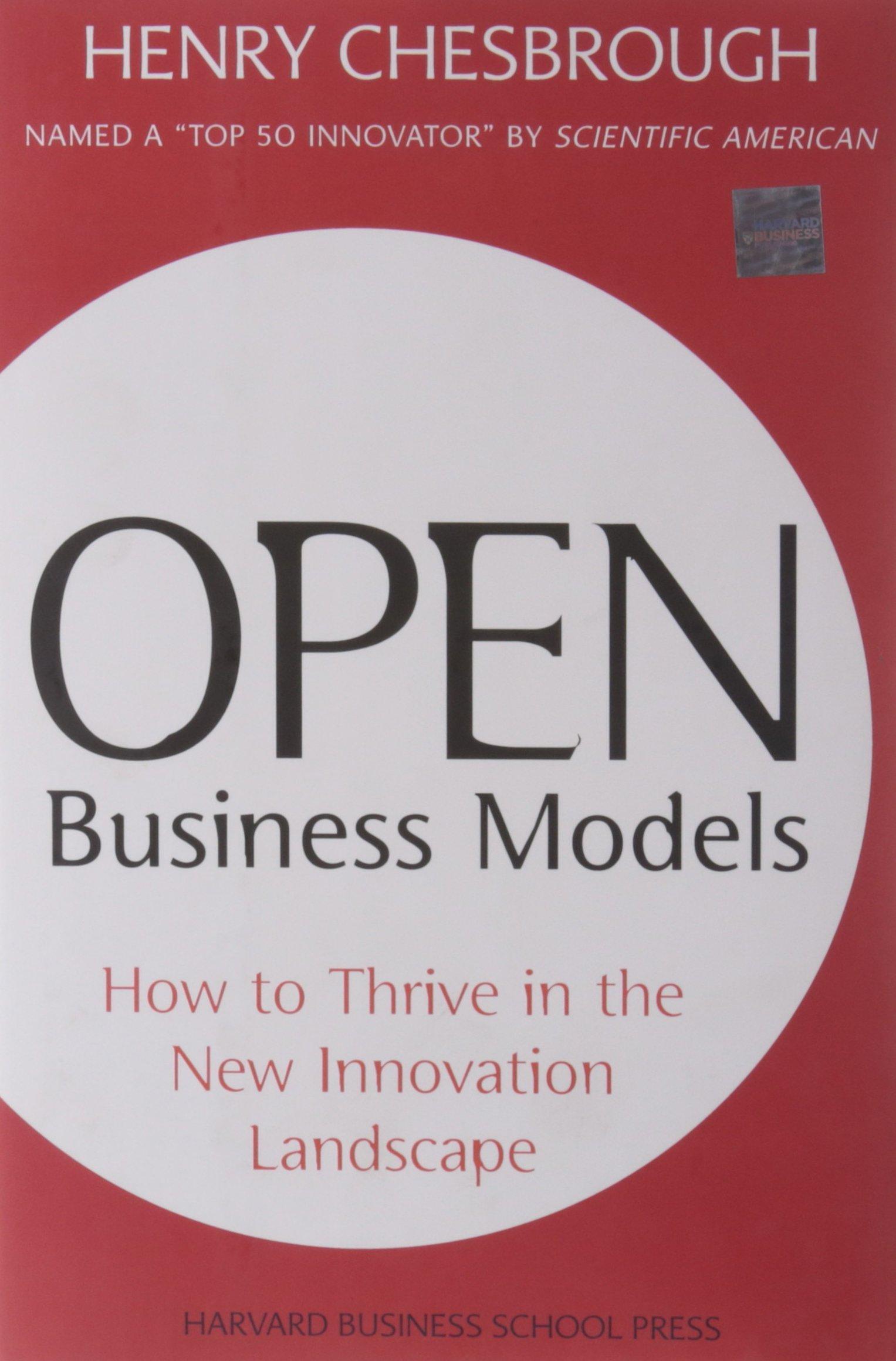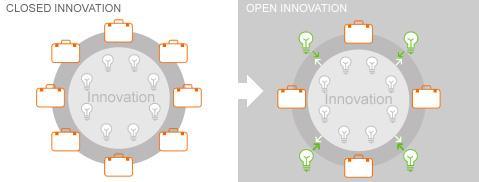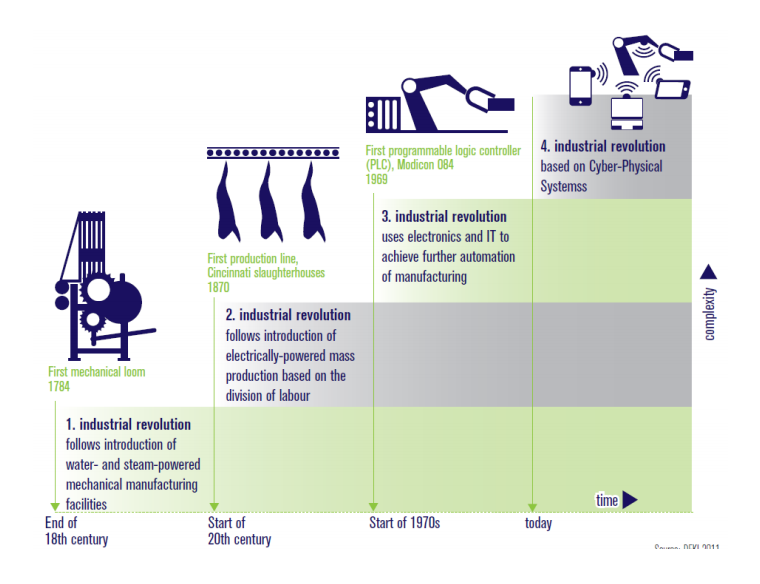Introducing Open Innovation
Open Innovation was defined as the use of purposive inflows and outflows of knowledge to accelerate internal innovation, and expand the markets for external use of innovation, respectively (Henry Chesbrough, 2003). Once open innovation is adpted, the organization's boundaries become permeable and that allows combining the company respurces with the external co-operators.
Closed innovation companies innovate by using only internal resources, usually during the innovation process, ideas are evaluated and only the best and most promising ones are selected for their development and commercialization. The ones that show less potential are abandoned. The difference between open and closed innovation is that in the case of closed innovation the ideas, inventions, investigations and developments required to place a product in the market, are generated within the company. However, when applying the open innovation system, the company can use external resources such as technology and at the same time make available their own innovations to other organizations.
Under the open innovation paradigm there is an important flow of external knowledge into the organization which turns into projects in co-operation with external partners and causes the purchase and incorporation of external technologies. At the same time, the innovations generated within the company can be sold as technology and/or industrial property to other organizations since either they are not applicable within their business model or because the company has no capacity or experience to develop the invention. The final result is that some products reach the market by using exclusively internal resources from the initial idea up to the commercialization of the final product. Other products are the result of incorporating external knowledge at different stages of their development.
There are clear advantages of opening the innovation process to the flow of ideas and knowledge in both directions. They can be summed up as follows:
- Reduction in the time and cost of innovation projects
- Incorporation of solutions and innovations in the form of ideas, patents, products and technologies which would have never been generated by the company due to lack of time, knowledge and technological resources
- Commercialization of inventions which due to lack of ability or to strategic reasons cannot be places in the market by the company owning them
From Closed to Open Innovation
Quoting Hester Tak, Partner at Gunn & Twynmore, P&G was one of the first to drastically change things. Although they were not a pharmaceutical company but a personal care and household product company, they, too, had issues with finding and developing their new innovations and were suffering from lack of customer loyalty. Their new CEO, A.G. Lafley, first expressed the idea that no matter how good the staff was at P&G and how many ideas they had, it was only a fraction of the total intellectual pool available worldwide. Lafley's new way of thinking led to P&D's Connect & Develop program which has been very successful for them. With this program, P&G created an “open innovation” trend, which was followed by many others in some form. The pharmaceutical industry was quick to follow and as a sector, probably have had the most experience in open innovation practices. However, other sectors, including electric engineering, aviation and publishing companies are adopting similar practices.
From Closed to Open Innovation
As described above, P&G's Connect & Develop program took a completely different approach to creation and development. Until then, virtually all large multinationals operated the same way. They innovated from within their own R&D centers. There was a strong belief that a company should control the creation and management of ideas – and, therefore, its IP. There are 5 common beliefs related to closed innovation1:
- The smart people in the field always work for us
- To profit from R&D, we must discover it, develop it, and ship it ourselves
- If we discover it ourselves, we will get it to the market first
- If we create the most and the best ideas in the industry, we will win
- We should control our IP, so that our competitors don't profit from our ideas
Often, closed innovation paradigms are used interchangeably with “Not Invented Here” syndrome. It is also sometimes referred to by decision makers as “everything coming from outside is suspicious and not reliable”.
Open Innovation
Although the term 'closed innovation' is well defined and understood by most companies to mean the same thing, there is a wide variation on the definition of open innovation. At the heart of all the definitions, there is a common basis namely involving externals for the acquisition of new ideas or products by sharing knowledge and IP. The extent to which these externals are used varies per company. For example, some companies will practice open innovation by having a portal on their website which externals e.g. citizens can submit their ideas to the firm. The firm will review and select those that they think will enhance their business and the submitter gets a small reward in turn. Other firms embrace the term more broadly and will go as far as sharing their campus or even their labs with external parties. Therefore, when a company claims they are involved in open innovation, it is worthwhile to investigate how they have interpreted the term.
In a similar way as above, 5 principles have been defined for open innovation2.
- Not all the smart people work for us, so we must find and tap into the knowledge and expertise of bright individuals outside our company
- External R&D can create significant value: internal R&D is needed to claim some portion of that value
- We don't have to originate the research in order to profit from it
- If we make the best use of internal and external ideas, we will win
- We should profit from others' use of our IP, and we should buy others' IP whenever it advances our business model
Things to consider in Open Innovation partnering strategies
In any partnering strategy there are a few things that need to be considered at the outset such as whether each organization is prepared to collaborate, what strengths each organization brings to the partnership, the objectives and performance criteria for the partnership, how the partners structure and manage their alliance and what benefit does each party hope to gain from the partnership.
When engaging with powerful minds outside the organization powerful support roles within the firm are demanded. However, there is not one single Open Innovation champion. Innovation processes are complex and involve different persons, departments, and disciplines. Therefore, different roles are required to overcome inertia in complex innovation projects. Three types of roles or 'promoters' can help an organization to overcome the internal forces that can potentially hinder open innovation. These promoters can be differentiated according to their base of power: (1) the power promoter is a person who has the hierarchical power to drive a project, to provide necessary resources, and to help to overcome obstacles concerning will and bureaucracy that might arise during the course of a project. The second promoter, the expert promoter, describes a person who has the specific technical knowledge for the innovation problem at hand and overcomes barriers of ability. These barriers are often the result from a lack of knowledge in the field of a specific domain. Thirdly, the process promoter derives her influence from organizational know-how and intra- organizational social networks. This individual establishes and maintains the connection between the power promoter, the expert promoter, as well as other project members who are willing and able to contribute to an Open Innovation project but who do not have the permission to do so due to existing internal rules or limited capacity and resources3
Tools to interact with other non-sector specialists
Many tools have been developed to connect firms with external parties. Some of these tools are embedded on the website of the firms but there are also specific service firms that facilitate this such as Innoget. Innoget allows firms to express what knowledge, expertise or technology they are looking for. However, the tool also allows these same firms, as well as others, and academia, to showcase technologies that they may have but do not fit (anymore) with their current and future product development strategy. These technologies are then offered for licensing. Other tools, such as dedicated 'part-up' or partnering events are of a more personal interaction between parties and aims to bring people who need expertise together with people who have the desired knowledge.
The Fourth Revolution
As described by Hester Tak, the Fourth Revolution is currently ongoing. Here, companies are looking to analyse Big Data - a collection of data from traditional and digital sources inside and outside a company that represents a source for ongoing discovery and analysis. In defining big data, it's also important to understand the mix of unstructured and multi-structured data that comprises the volume of information. Unstructured data includesinformation such as metadata en social media posts. Multi-structured data includes a variety of data formats and types and can be derived from interactions between people and machines, such as web applications or social networks. Examples of multi-structured data include web log data, a combination of text and visual images along with structured data like form or transactional information. The insights gained at each step in the analyses can help improve customer engagement strategies. Big data information is often a reflection of society's ideas, thoughts and behavior. It has given society a stronger voice – also towards firms.
In the last 10-15 years, the term Triple Helix was coined to indicate the complementary and interdependent relationship between the government, academia and industry. With the Fourth Revolution, a quadruple helix has now been formed – adding citizens and society as the fourth strand.
Open Innovation Books
To learn more about Open Innovation, check Innoget's curated list of Open Innovation Books below:

A Guide to Open Innovation and Crowdsourcing: Advice from Leading Experts in the Field
Author(s): Paul Sloane
Author Paul Sloane explains how to use the power of ideas and people outside your organization to turbocharge your innovation. A close look to open innovation, crowdsourcing and outsourcing.
Read more 
Open Innovation: The New Imperative for Creating and Profiting from Technology
Author(s) : Henry William Chesbrough
Harvard Professor Henry W. Chesbrough describes in this path-breaking analysis how open innovation can unlock the latent economic value in a company’s ideas and technologies.
Read more 
Open Innovation Models: How to Thrive In the New Innovation Landscape
Author(s) : Henry William Chesbrough
While Henry Chesbrough demonstrated in his landmark book “Open Innovation” that because useful knowledge is no longer concentrated in a few large organizations, business leaders must adopt a new “open” model of innovation, in “Open Innovation Models”, Chesbrough takes readers to the next step, describing how to make money in an open innovation landscape.
Read more 
Open Services Innovation: Rethinking Your Business to Grow and Compete in a New Era
Author(s) : Henry Chesbrough
Henry Chesbrough offers in his new book a new approach that demonstrates how open innovation combined with a services approach to the industry is an effective and powerful way to grow.
Read more 

